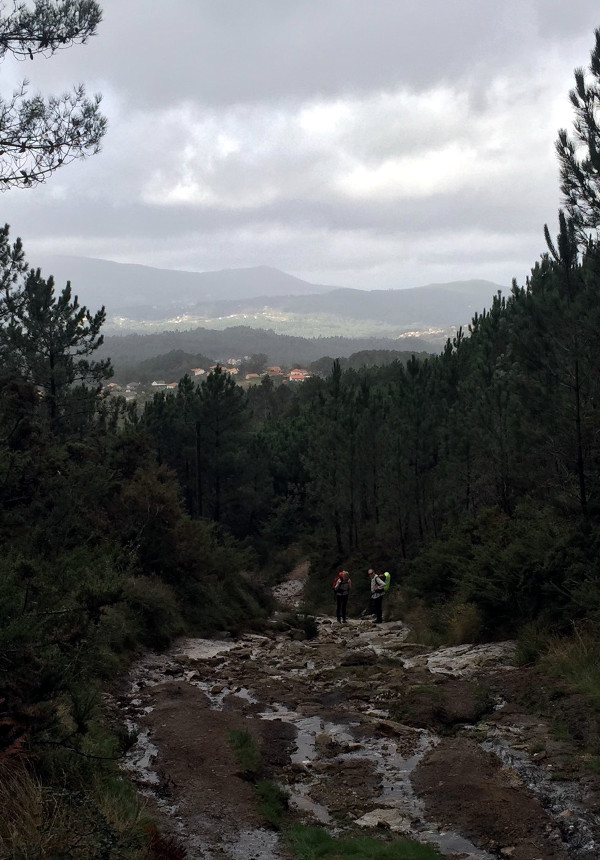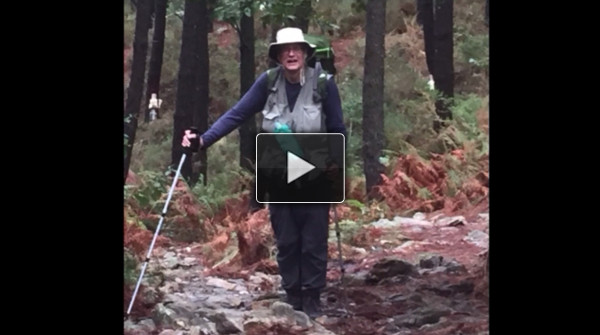
On the pilgrimage trail to Santiago di Compostela
From 30th September to 14th October I walked with friends along one of the old pilgrim trails to Santiago di Compostela. This shrine in Spain’s Northwestern Province of Galicia has been the destination of Christian pilgrims for 1000 years. In the great Cathedral lies the body of St James, Son of Zebedee, one of the Twelve Apostles (or so it is believed). In the heyday of pilgrimages in the 11th and 12th Century, Santiago ranked with Jerusalem, Rome, Canterbury and Cologne as a holy destination. Nowadays it is still a place of religious pilgrimage. For many non-Catholics, however, the journey – the Camino or Way – is worth taking for itself, for some as a physical challenge, for others as a meditation or retreat.
The most famous of the Caminos is the one starting in St Jacques in France, crossing the Pyrenees and then the length of northern Spain, a month long journey covering 1000 km – but in truth there are as many Caminos as there are roads to Santiago. We chose a southern route, the Caminho Portuguese. We started walking north from Porto and it took 12 days and 250 km to reach Santiago. From there we traveled on (by car) to Cape Finisterre, one of the most western points on the Eurasian continent, and to Muxia, where the Atlantic waves crash on the rocks by a small church and a pillar marks the end of all Caminos. We then travelled by road to see the great Cathedrals in Lugo, Leon and Burgos, finally taking a ferry from Santander to Portsmouth (as near as we could get to the old Camino Inglese or English Way, which in old times involved a dangerous sea journey from Plymouth to Corunna).
One of the advantages of the southern route is that one can spend time in two distinct countries with different styles and manners, foods and wines ( the Douro reds and the Minho Vino Verde are fantastic). One can also in Sept/Oct pick grapes as one walks. Much of the journey is through farmland and vineyards. The people one meets are friendly and encouraging, proud of the Camino and respectful of those undertaking the journey. Once all this country belonged to the ancient kingdom of Galicia. A Celtic resonance is still there, rather as it is in Cornwall and Brittany. The people call encouragingly to you as you pass “Bon Caminho!”
The countryside on the walk is beautiful and various. On the first day out of Porto you can take the coastal route with its black rocks and Atlantic breakers, finding old fishing villages and Neolithic remains along the way. Inland the route takes you through lovely farmland, but also up mountains and through forests. Always there are yellow arrows on stones at crossroads to guide you through the most scenic and rural of paths, though sometimes you can’t avoid soul destroying sessions on highways or the suburbs of towns. The compensation is that when one reaches the old parts of the towns they are usually beautiful. Much that is medieval remains in cities like Barcelos, Pontevedra, Tui, Ponte de Lima, Redondela and of course Porto and Santiago itself. Caldas de Reis is a spa town with hot sulphur baths.
The walk itself was never too hard. The mountains we climbed were comparatively small (the highest 450 meters). It is worth reading all the stuff on Santiago websites about preparations (how much and what to carry, what clothes to wear, how to look after your feet, minimizing blisters etc.). There is of course strain on the knees in some of the descents. But nothing too tough – though the long distances take their toll. After 20 km we felt the going hard and we were usually at the end of our tether the last couple of kilometers before reaching destination. But stiffness goes and one revives quickly after a bath (if one can find one) and a good meal, NOT difficult to find in either Portugal or Spain, is enough to restore all energies.
The strain on this sort of trip is not physical but mental. The fact is that it is not just a walk in the countryside. Something else is going on. It’s as if there is another world touching this one, a metaphysical influence somehow guiding events, or as if the whole walk is a reality show where you are an inadvertent participant in a game where invisible producers are pulling the strings. The pricking of vanity and self delusion is relentless. It is tempting (and maybe even true in its way in view of the nature of what is still considered to be a pilgrimage) to see some of the people one meets or the events that overtake you as elemental forces put in the pilgrim’s path, John Bunyan-like, for good or bad, metaphorically to represent threats or temptations.
By the end of the trip when all three of us made our crippled way into the cathedral square in Santiago we felt wiser if chastened and exhausted on every level – physical, mental and emotional – and we shared a feeling of companionship and friendship that will probably last the rest of our lives. And our mood in the square I can only describe as exultation. We staggered about in our filthy walking gear like drunken tramps, gazing at the spires in wonder. And next morning, early, we went and got our certificates from the Camino office. Jupiter and Venus were clearly visible in the pre dawn sky near a crescent moon. We attended a small mass in the Cathedral. In the British chapel, Allegri’s Miserere was playing. Later we attended the noon Mass for pilgrims. The music undid me. I huddled by a confessional and wept.
Books to read
On pilgrimages generally there is the excellent history by Jonathan Sumption, called Pilgrimage. The only guidebook in English is Caminho Portuguese by John Brierley, There is also a superb German guide in Verlag’s Outdoor Handbuch series called Portugal-Spanien: Jakobsweg – Caminho Portuguese Von Porto Mach Santiago und Finisterre by Raimund Joos.



Leave a Comment